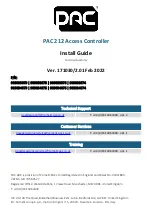ColdFire Core
Freescale Semiconductor
7-15
MCF51CN128 Reference Manual, Rev. 6
7.3.3.3
Illegal Instruction Exception
The default operation of the V1 ColdFire processor is the generation of an illegal opcode reset event if an
illegal instruction is detected. If CPUCR[IRD] is set, the reset is disabled and a processor exception is
generated as detailed below. There is one special case involving the ILLEGAL opcode (0x4AFC)
;
attempted execution of this instruction always generates an illegal instruction exception, regardless of the
state of the CPUCR[IRD] bit.
The ColdFire variable-length instruction set architecture supports three instruction sizes: 16, 32, or 48 bits.
The first instruction word is known as the operation word (or opword), while the optional words are known
as extension word 1 and extension word 2. The opword is further subdivided into three sections: the upper
four bits segment the entire ISA into 16 instruction lines, the next 6 bits define the operation mode
(opmode), and the low-order 6 bits define the effective address. See
definition is shown in
.
Figure 7-11. ColdFire Instruction Operation Word (Opword) Format
15
14
13
12
11
10
9
8
7
6
5
4
3
2
1
0
Line
OpMode
Effective Address
Mode
Register
Table 7-9. ColdFire Opword Line Definition
Opword[Line]
Instruction Class
0x0
Bit manipulation, Arithmetic and Logical Immediate
0x1
Move Byte
0x2
Move Long
0x3
Move Word
0x4
Miscellaneous
0x5
Add (ADDQ) and Subtract Quick (SUBQ), Set according to Condition Codes (Scc)
0x6
PC-relative change-of-flow instructions
Conditional (Bcc) and unconditional (BRA) branches, subroutine calls (BSR)
0x7
Move Quick (MOVEQ), Move with sign extension (MVS) and zero fill (MVZ)
0x8
Logical OR (OR)
0x9
Subtract (SUB), Subtract Extended (SUBX)
0xA
Move 3-bit Quick (MOV3Q)
0xB
Compare (CMP), Exclusive-OR (EOR)
0xC
Logical AND (AND), Multiply Word (MUL)
0xD
Add (ADD), Add Extended (ADDX)
0xE
Arithmetic and logical shifts (ASL, ASR, LSL, LSR)
0xF
Write DDATA (WDDATA), Write Debug (WDEBUG)

















